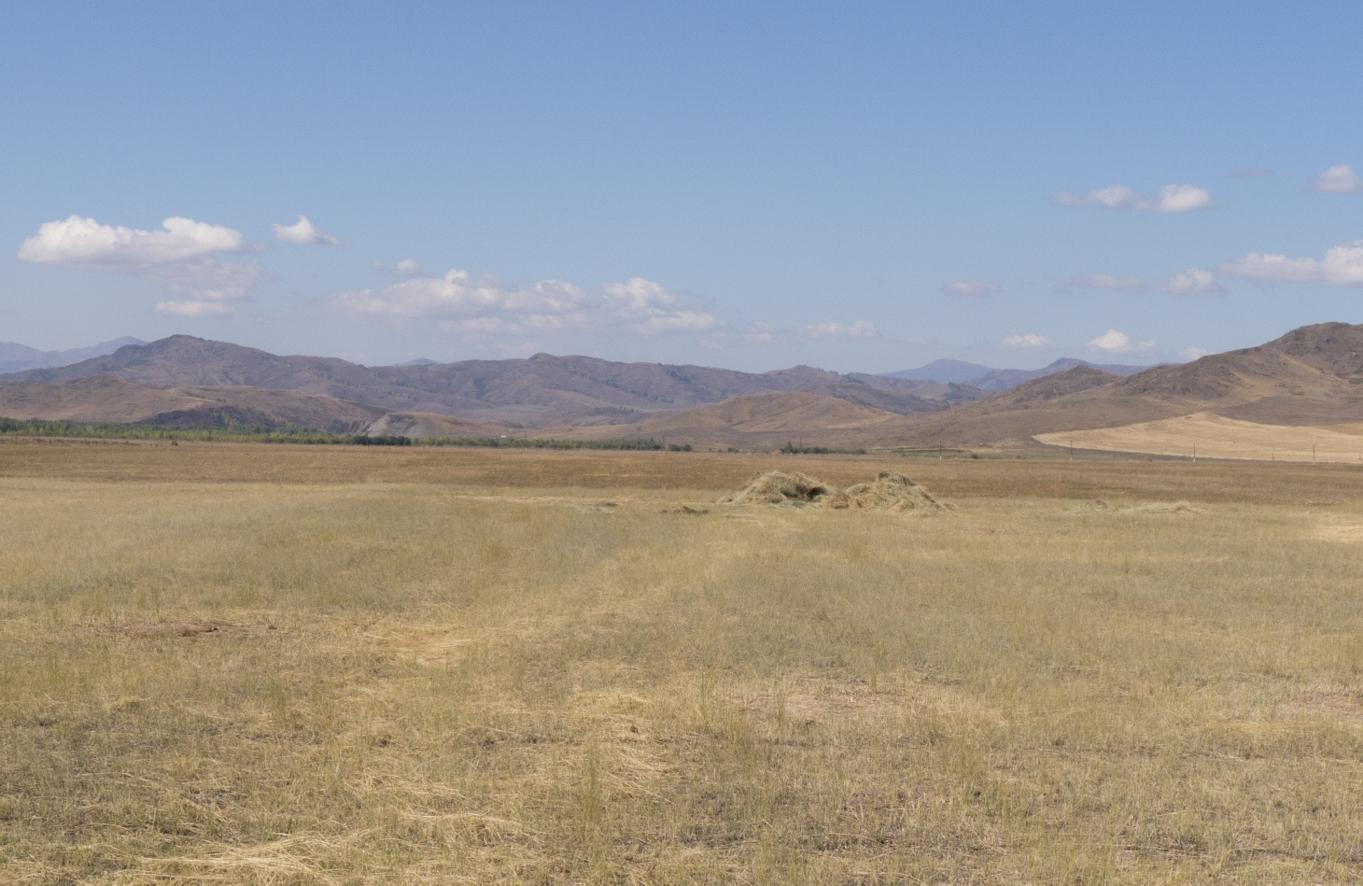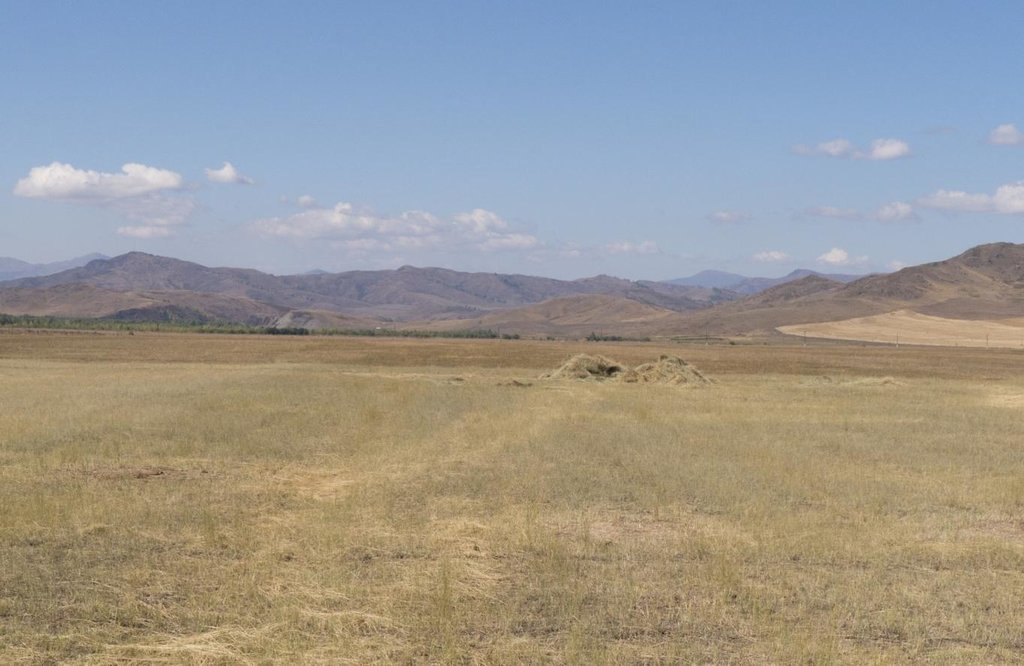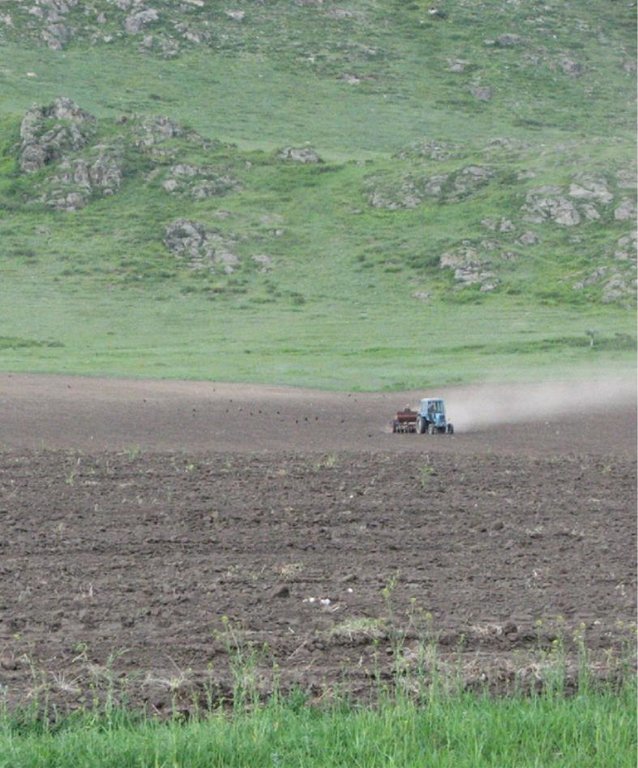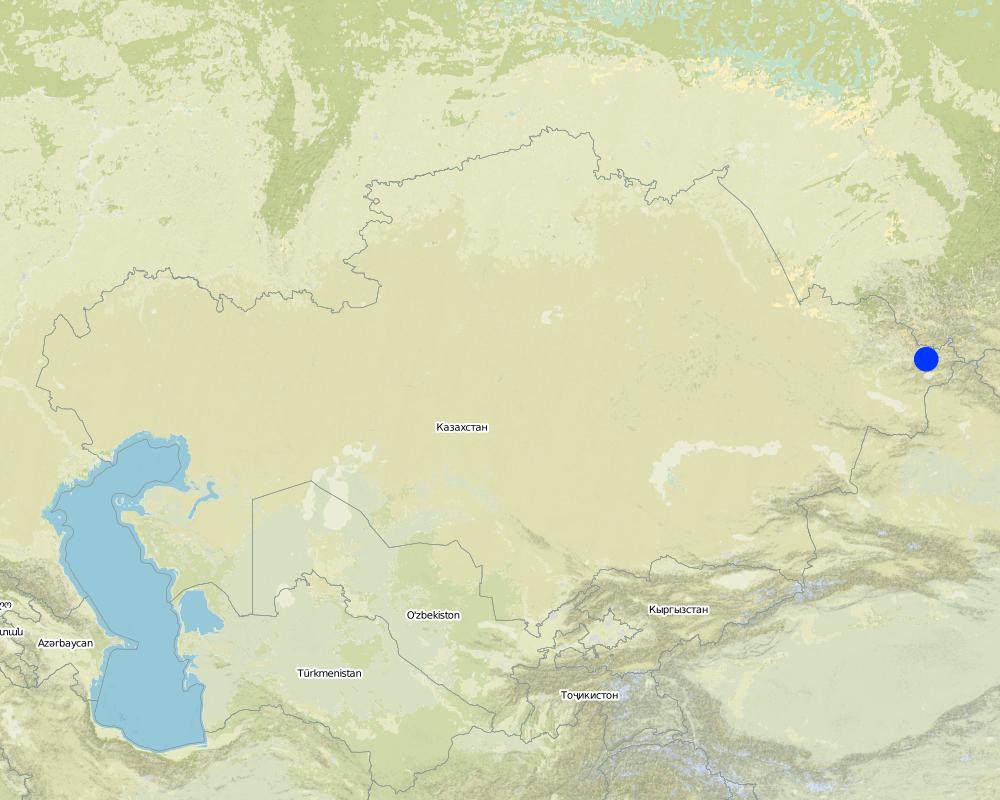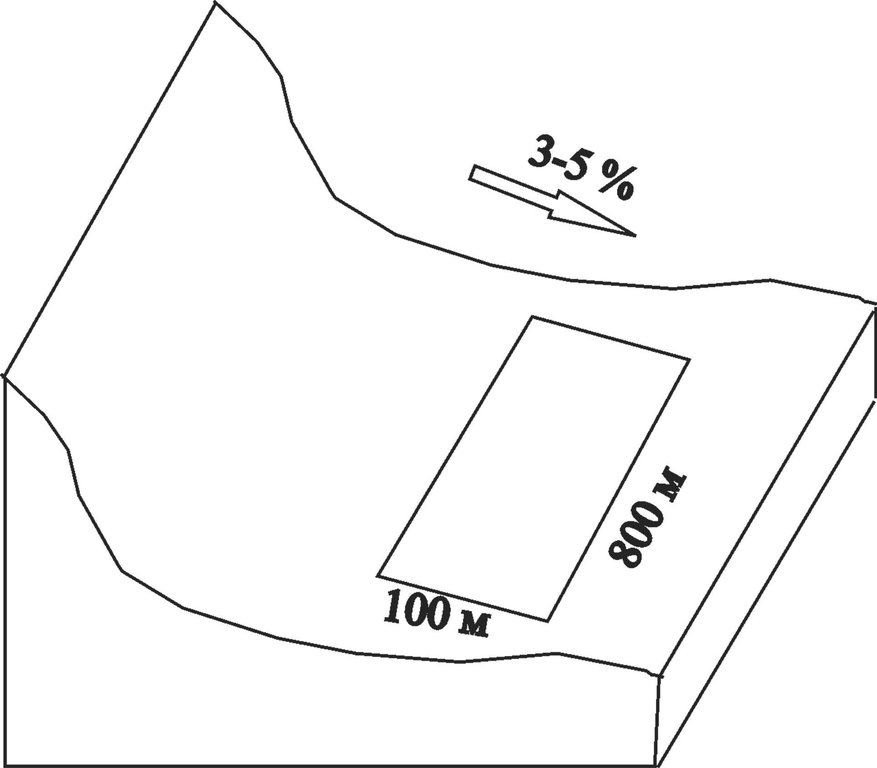Creation of a perennial grass seed area (CACILM) [Kazakhstan]
- Creation:
- Update:
- Compiler: Konstantin Pachikin
- Editor: –
- Reviewers: Fabian Ottiger, Alexandra Gavilano
Central Asian Countries Initiative for Land Management (CACILM/ИСЦАУЗР)
technologies_1115 - Kazakhstan
View sections
Expand all Collapse all1. General information
1.2 Contact details of resource persons and institutions involved in the assessment and documentation of the Technology
Key resource person(s)
land user:
Bakimbayev Toktasyn
”Mametek” FA
Kazakhstan
SLM specialist:
Cheranev Vladimir
Ust-Kamenogorsk,
Name of project which facilitated the documentation/ evaluation of the Technology (if relevant)
Central Asian Countries Initiative for Land Management (CACILM I)Name of the institution(s) which facilitated the documentation/ evaluation of the Technology (if relevant)
Kazakh Research Institute for Soil Science and Agr (Kazakh Research Institute for Soil Science and Agr) - Kazakhstan1.3 Conditions regarding the use of data documented through WOCAT
The compiler and key resource person(s) accept the conditions regarding the use of data documented through WOCAT:
Yes
1.5 Reference to Questionnaire(s) on SLM Approaches (documented using WOCAT)
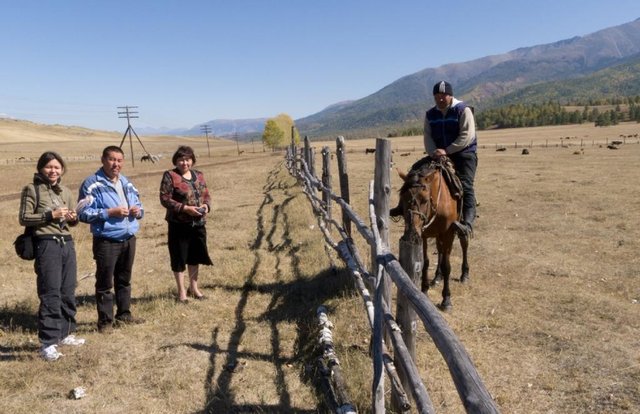
Rangeland management through the restoration of distant stock-breeding … [Kazakhstan]
The restoration of degraded rangelands and the improvement of their productivity through the organization of distant stock-breeding and the introduction of pasture rotation (in the frame of CACILM).
- Compiler: Konstantin Pachikin
2. Description of the SLM Technology
2.1 Short description of the Technology
Definition of the Technology:
Improvement of pastures through planting perennial legumes, cereals and grasses and creating seed banks.
2.2 Detailed description of the Technology
Description:
As a result of an increase in the number of livestock pastures were overstocked and soil and vegetation cover was degraded. To restore pastures in the area surrounding the Katon-Karagay village, a technology to improve pastures through sowing perennial legumes (sainfoin, lucerne, eastern galega), cereals (smooth brome, orchard grass, Russian wild rye), forage crops and mixed grasses was developed within the framework of the GEF/SGP “Organization of Katon-Karagay Village Pasture Management to Minimize Land Degradation” Project. The introduction of this technology allows for an increase in pasture productivity, and an improvement in the quality and weight of livestock. This leads to an increase in the income and improvement in the quality of life for the local population. The technology was applied to an area of 80 ha surrounding the Katon-Karagay village, where previously intensive livestock grazing was practiced. At present this area is under a short-term lease (5 years) to the "Mametek" Farmers’ Association (FA). The technology was introduced within the framework of the approach on "Pasture management through restoration of distant stock-breeding system and drastic improvement of pastures", in which "Mametek" FA is one of the key parties. Practice is documented in the frame of CACILM.
Purpose of the Technology: The purpose was to restore the degraded area surrounding Katon-Karagay village for later use as a pasture, to secure perennial grass and cereal seed production for the restoration of degraded pastures and to improve pasture productivity in other areas.
Establishment / maintenance activities and inputs: The establishment and maintenance activities include fencing of the area to prevent the destruction of crops by livestock. Soil processing - plowing to a depth of 25-27 cm with subsequent harrowing and evening. Spring sowing of cover crops (barley, oats) to a depth of 5-10 cm. After cover crops are sown, perennial grasses and cereals should be sown to a depth of 2-3 cm. They should be sown in the same area as the one-year crops. One-year crops and perennial forage crops should be mown annually in autumn. The seeds for sowing in other areas should be collected in the 3 years after sowing. The seeds are intended for the further restoration of pastures in other areas. To utilize the technology the following initial activities should be conducted: purchase of materials (poles, wire), soil processing (leasing of tractors and seeders), purchase of seeds for sowing, leasing of machinery for mowing and taking away the hay. The work should be conducted by the farmers’ association with an additional labour force for a period of up to 15 days. Since the grasses are perennial, there is no need for further activities, only nitric fertilizers should be applied from time to time.
Natural / human environment: The project area is situated in an inter-mountain valley at a height of about 1000 m. The area is located within a semi-arid natural zone. The area is located within the Katon-Karagay State Natural Park and has limited economic use, mainly as pasture
2.3 Photos of the Technology
2.5 Country/ region/ locations where the Technology has been applied and which are covered by this assessment
Country:
Kazakhstan
Region/ State/ Province:
Kazakhstan
Further specification of location:
East-Kazakhstan
Specify the spread of the Technology:
- evenly spread over an area
If the Technology is evenly spread over an area, specify area covered (in km2):
0.8
If precise area is not known, indicate approximate area covered:
- 0.1-1 km2
Comments:
Total area covered by the SLM Technology is 0.8 km2.
Map
×2.6 Date of implementation
If precise year is not known, indicate approximate date:
- 10-50 years ago
2.7 Introduction of the Technology
Specify how the Technology was introduced:
- through projects/ external interventions
Comments (type of project, etc.):
GEF/SGP “Organization of Katon-Karagay Village Pasture Management to Minimize Land Degradation” Project 2009-2011
3. Classification of the SLM Technology
3.2 Current land use type(s) where the Technology is applied
Land use mixed within the same land unit:
Yes
Specify mixed land use (crops/ grazing/ trees):
- Agro-pastoralism (incl. integrated crop-livestock)

Cropland
- Annual cropping
- Perennial (non-woody) cropping
Annual cropping - Specify crops:
- fodder crops - alfalfa
- fodder crops - grasses
- sainfoin (Onobrychis), smooth brome (Bromus inermis)
Perennial (non-woody) cropping - Specify crops:
- flower crops - perennial
Number of growing seasons per year:
- 1
Specify:
Longest growing period in days: 150 Longest growing period from month to month: May-September

Grazing land
Extensive grazing:
- Ranching
- Intensive grazing / fodder production
Animal type:
- horses
- sheep
- cows
Comments:
Main crop: legumes (sainfoin, lucerne (alfalfa), eastern galega) and cereals (smooth brome, orchardgrass, Russian wildrye)
Major land use problems (compiler’s opinion): Soil and vegetation degradation as a result of overgrazing
Major land use problems (land users’ perception): Reduction of pasture productivity as a result of unregulated land use
Ranching: Sheep, cows. horses
Future (final) land use (after implementation of SLM Technology): Grazing land: Gi: Intensive grazing/ fodder production
Livestock density (if relevant): 1-10 LU /km2
3.3 Has land use changed due to the implementation of the Technology?
Has land use changed due to the implementation of the Technology?
- Yes (Please fill out the questions below with regard to the land use before implementation of the Technology)

Grazing land
- Extensive grazing
3.4 Water supply
Water supply for the land on which the Technology is applied:
- rainfed
Comments:
Водопотребление: богарное, богарное
3.6 SLM measures comprising the Technology

vegetative measures
- V2: Grasses and perennial herbaceous plants

structural measures
- S6: Walls, barriers, palisades, fences
Comments:
Основные мероприятия: связанные с использованием растительности, инженерные
3.7 Main types of land degradation addressed by the Technology

soil erosion by water
- Wt: loss of topsoil/ surface erosion

chemical soil deterioration
- Cn: fertility decline and reduced organic matter content (not caused by erosion)

biological degradation
- Bc: reduction of vegetation cover
Comments:
Main causes of degradation: overgrazing (Excesses in the allowable number of grazing livestock), population pressure (Intensive use of land surrounding the village)
3.8 Prevention, reduction, or restoration of land degradation
Specify the goal of the Technology with regard to land degradation:
- prevent land degradation
- reduce land degradation
Comments:
Основная цель: снижение деградации земель, предотвращение деградации земель
4. Technical specifications, implementation activities, inputs, and costs
4.1 Technical drawing of the Technology
Technical specifications (related to technical drawing):
The 80 ha of land are located 3 km northeast of Katon-Karagay village in the upper part of an inter-mountain valley turning to mountain slopes. The surface is undivided and has a slope of 3-5 %.
Location: the area surrounding Katon-Karagay village. Katon-Karagay
Date: 2011-11-16
Technical knowledge required for field staff / advisors: high (Technology training)
Technical knowledge required for land users: high (Technology observance)
Main technical functions: increase of biomass (quantity), promotion of vegetation species and varieties (quality, eg palatable fodder)
Secondary technical functions: improvement of ground cover, improvement of topsoil structure (compaction), increase in nutrient availability (supply, recycling,…), increase / maintain water stored in soil
Vegetative measure: Sowing of perenial grasses
Vegetative material: G : grass
Number of plants per (ha): 2-3 millions
Spacing between rows / strips / blocks (m): 0.5-0.6
Vertical interval within rows / strips / blocks (m): 0.01
Vegetative measure: Vegetative material: G : grass
Vegetative measure: Vegetative material: G : grass
Vegetative measure: Vegetative material: G : grass
Perennial crops species: legumes (sainfoin, lucerne, eastern galega) and cereals (smooth brome, orchardgrass, Russian wildrye
Structural measure: fence
Spacing between structures (m): 20
Construction material (wood): Columns
Construction material (other): Wire
Author:
Konstantin Pachikin, Almaty
4.2 General information regarding the calculation of inputs and costs
other/ national currency (specify):
tenge
If relevant, indicate exchange rate from USD to local currency (e.g. 1 USD = 79.9 Brazilian Real): 1 USD =:
149.6
4.3 Establishment activities
| Activity | Timing (season) | |
|---|---|---|
| 1. | Acquiring of seeds | autumn or early spring |
| 2. | Plowing | spring |
| 3. | Harrowing | spring |
| 4. | Sowing | spring |
| 5. | Covering | spring |
| 6. | Fencing of the area | Spring |
4.4 Costs and inputs needed for establishment
| Specify input | Unit | Quantity | Costs per Unit | Total costs per input | % of costs borne by land users | |
|---|---|---|---|---|---|---|
| Labour | Plowing | person/day | 4.0 | 25.0 | 100.0 | 100.0 |
| Labour | Fencing | person/day | 5.0 | 25.0 | 125.0 | 100.0 |
| Labour | Harrowing | person/day | 4.0 | 25.0 | 100.0 | 100.0 |
| Labour | Sowing | person/day | 8.0 | 25.0 | 200.0 | 100.0 |
| Equipment | Machine use plowing | machine hours | 128.0 | 15.57 | 1992.96 | |
| Equipment | Machine use harrowing | hamachine hours | 48.0 | 16.666666 | 800.0 | |
| Equipment | Machine use sowing | machine hours | 48.0 | 16.66666 | 800.0 | |
| Equipment | Machine use covering | machine hours | 64.0 | 6.859 | 438.98 | |
| Plant material | Seeds | kg/ha | 12.5 | 5.6 | 70.0 | |
| Construction material | Wire, poles | km | 3.2 | 93.75 | 300.0 | 100.0 |
| Other | Labour: Covering | person/days | 8.0 | 25.0 | 200.0 | 100.0 |
| Total costs for establishment of the Technology | 5126.94 | |||||
| Total costs for establishment of the Technology in USD | 34.27 | |||||
4.5 Maintenance/ recurrent activities
| Activity | Timing/ frequency | |
|---|---|---|
| 1. | Mowing of grasses | September |
4.6 Costs and inputs needed for maintenance/ recurrent activities (per year)
| Specify input | Unit | Quantity | Costs per Unit | Total costs per input | % of costs borne by land users | |
|---|---|---|---|---|---|---|
| Labour | Mowing of grass | person days | 8.0 | 25.0 | 200.0 | 100.0 |
| Equipment | Machine use for mowing of the grass | machine hours | 64.0 | 9.375 | 600.0 | |
| Total costs for maintenance of the Technology | 800.0 | |||||
| Total costs for maintenance of the Technology in USD | 5.35 | |||||
Comments:
Machinery/ tools: tractor, plow, harrow, seeder
4.7 Most important factors affecting the costs
Describe the most determinate factors affecting the costs:
Thin-layer and stony soil impacts the costs, labor force should be hired
5. Natural and human environment
5.1 Climate
Annual rainfall
- < 250 mm
- 251-500 mm
- 501-750 mm
- 751-1,000 mm
- 1,001-1,500 mm
- 1,501-2,000 mm
- 2,001-3,000 mm
- 3,001-4,000 mm
- > 4,000 mm
Agro-climatic zone
- sub-humid
Thermal climate class: temperate
5.2 Topography
Slopes on average:
- flat (0-2%)
- gentle (3-5%)
- moderate (6-10%)
- rolling (11-15%)
- hilly (16-30%)
- steep (31-60%)
- very steep (>60%)
Landforms:
- plateau/plains
- ridges
- mountain slopes
- hill slopes
- footslopes
- valley floors
Altitudinal zone:
- 0-100 m a.s.l.
- 101-500 m a.s.l.
- 501-1,000 m a.s.l.
- 1,001-1,500 m a.s.l.
- 1,501-2,000 m a.s.l.
- 2,001-2,500 m a.s.l.
- 2,501-3,000 m a.s.l.
- 3,001-4,000 m a.s.l.
- > 4,000 m a.s.l.
5.3 Soils
Soil depth on average:
- very shallow (0-20 cm)
- shallow (21-50 cm)
- moderately deep (51-80 cm)
- deep (81-120 cm)
- very deep (> 120 cm)
Soil texture (topsoil):
- medium (loamy, silty)
Topsoil organic matter:
- high (>3%)
5.4 Water availability and quality
Ground water table:
> 50 m
Availability of surface water:
good
5.5 Biodiversity
Species diversity:
- medium
5.6 Characteristics of land users applying the Technology
Market orientation of production system:
- mixed (subsistence/ commercial)
Off-farm income:
- less than 10% of all income
Relative level of wealth:
- poor
- average
Individuals or groups:
- cooperative
Level of mechanization:
- mechanized/ motorized
Gender:
- women
- men
Indicate other relevant characteristics of the land users:
Land users applying the Technology are mainly Leaders / privileged
Population density: 10-50 persons/km2
Annual population growth: < 0.5%
Relative level of wealth: rich, average, poor
5% of the land users are rich.
20% of the land users are average wealthy.
75% of the land users are poor.
5.7 Average area of land used by land users applying the Technology
- < 0.5 ha
- 0.5-1 ha
- 1-2 ha
- 2-5 ha
- 5-15 ha
- 15-50 ha
- 50-100 ha
- 100-500 ha
- 500-1,000 ha
- 1,000-10,000 ha
- > 10,000 ha
Is this considered small-, medium- or large-scale (referring to local context)?
- small-scale
5.8 Land ownership, land use rights, and water use rights
Land ownership:
- state
Land use rights:
- leased
5.9 Access to services and infrastructure
health:
- poor
- moderate
- good
education:
- poor
- moderate
- good
markets:
- poor
- moderate
- good
energy:
- poor
- moderate
- good
roads and transport:
- poor
- moderate
- good
drinking water and sanitation:
- poor
- moderate
- good
financial services:
- poor
- moderate
- good
6. Impacts and concluding statements
6.1 On-site impacts the Technology has shown
Socio-economic impacts
Production
fodder production
Quantity before SLM:
100 kg/hectare
Quantity after SLM:
200 kg/hectare
fodder quality
animal production
risk of production failure
Income and costs
farm income
workload
Socio-cultural impacts
food security/ self-sufficiency
community institutions
SLM/ land degradation knowledge
conflict mitigation
situation of socially and economically disadvantaged groups
Ecological impacts
Water cycle/ runoff
surface runoff
evaporation
Soil
soil moisture
soil cover
soil loss
soil crusting/ sealing
nutrient cycling/ recharge
soil organic matter/ below ground C
Biodiversity: vegetation, animals
biomass/ above ground C
animal diversity
beneficial species
6.2 Off-site impacts the Technology has shown
damage on neighbours' fields
damage on public/ private infrastructure
6.3 Exposure and sensitivity of the Technology to gradual climate change and climate-related extremes/ disasters (as perceived by land users)
Gradual climate change
Gradual climate change
| Season | increase or decrease | How does the Technology cope with it? | |
|---|---|---|---|
| annual temperature | increase | well |
Climate-related extremes (disasters)
Meteorological disasters
| How does the Technology cope with it? | |
|---|---|
| local rainstorm | well |
| local windstorm | well |
Climatological disasters
| How does the Technology cope with it? | |
|---|---|
| drought | not well |
Hydrological disasters
| How does the Technology cope with it? | |
|---|---|
| general (river) flood | well |
6.4 Cost-benefit analysis
How do the benefits compare with the establishment costs (from land users’ perspective)?
Short-term returns:
slightly positive
Long-term returns:
very positive
How do the benefits compare with the maintenance/ recurrent costs (from land users' perspective)?
Short-term returns:
neutral/ balanced
Long-term returns:
very positive
6.5 Adoption of the Technology
Comments:
100% of land user families have adopted the Technology with external material support
1 land user families have adopted the Technology with external material support
Comments on acceptance with external material support: It was introduced by ”Mametek” Farmers’ Association with the participation of the local population
There is no trend towards spontaneous adoption of the Technology
Comments on adoption trend: No long-term lease
6.7 Strengths/ advantages/ opportunities of the Technology
| Strengths/ advantages/ opportunities in the land user’s view |
|---|
| The opportunity for additional income |
| An improvement in grass quality and forage base, an increase in livestock weight |
| Strengths/ advantages/ opportunities in the compiler’s or other key resource person’s view |
|---|
|
Land degradation stopped How can they be sustained / enhanced? An expansion in the use of the technology and interest of the local population will result in the restoration and greater productivity of a larger area. |
| High cost efficiency |
|
Low-cost technology How can they be sustained / enhanced? Due to its low initial investment, people will be interested in using the technology |
| Complete support by the population and local authorities |
6.8 Weaknesses/ disadvantages/ risks of the Technology and ways of overcoming them
| Weaknesses/ disadvantages/ risks in the land user’s view | How can they be overcome? |
|---|---|
| In the event of a change in the local administration, people are unsure if the lease will be renewed. | Efforts should be made to renew the lease when it expires |
| Weaknesses/ disadvantages/ risks in the compiler’s or other key resource person’s view | How can they be overcome? |
|---|---|
|
After a short-term lease expires, the opportunity for project extension is not clear |
Efforts should be made to renew the lease when it expires |
7. References and links
7.1 Methods/ sources of information
7.2 References to available publications
Title, author, year, ISBN:
Содержание и допустимые нормы нагрузки животных на землях населенных пунктов и многолетние травы, используемые для улучшения пастбищ и сенокосов. Серекпаев Н.А., 2010
Available from where? Costs?
С. Катон-Карагай / бесплатно
Links and modules
Expand all Collapse allLinks

Rangeland management through the restoration of distant stock-breeding … [Kazakhstan]
The restoration of degraded rangelands and the improvement of their productivity through the organization of distant stock-breeding and the introduction of pasture rotation (in the frame of CACILM).
- Compiler: Konstantin Pachikin
Modules
No modules


